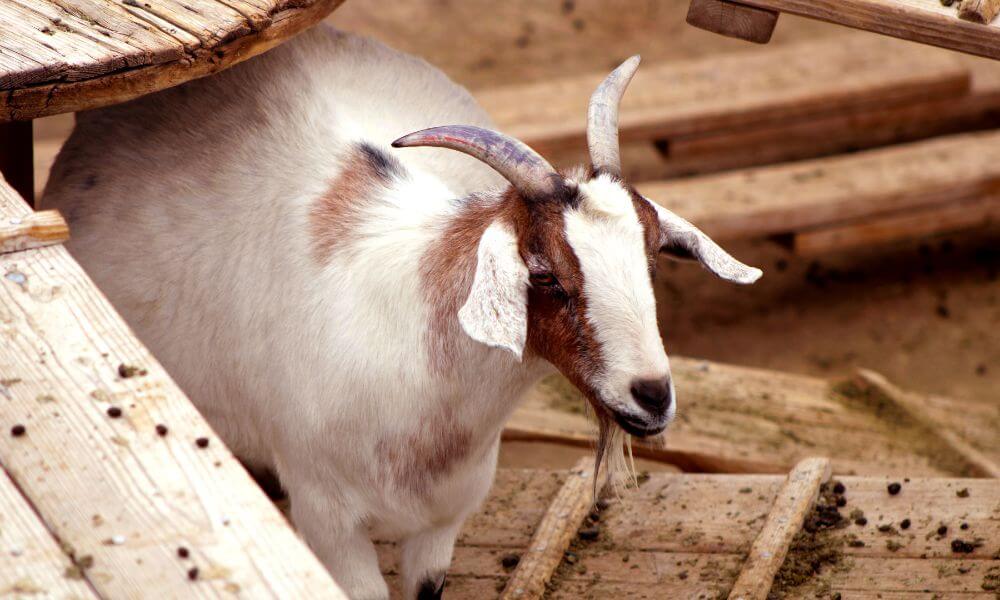Not many signs are going to present themselves immediately.
Like any pregnancy, it’s going to take time.
It will depend on the breed of goat, too, since some come into heat far more than others.
If your goat is on a monthly heat cycle, this will be the first sign.
Let’s look further into this.

How can you tell if a goat is pregnant?
So, there are many ways.
Let’s start with the earliest signs.
It will most likely start with a change in behavior.
A once friendly doe may become standoffish and uninterested in being touched or interacted with.
At the same time, a once unfriendly doe may become highly affectionate.
Either way, it’s about a change from the original state of behavior.
This goes for the males, too, if they’re kept near the females.
Then, think about when they were last in heat, and if they ought to be going into heat again.
If they don’t, this is a good sign that they are pregnant.
After around a month or two, you’ll start to notice the physical signs.
The barrel swelling, and the overall shape will begin to change.
Measure your doe’s barrel at the first stage after mating, then again a few weeks later.
If there’s a change, it could indicate pregnancy.
Then the udder will start to swell, and the doe may even snore a lot more at night.
These are all the main signs.
So, what about how far along they are?
How can you tell how far along a goat is?
This is really going to be a simple numbers game.
As I said, measuring the barrel is really helpful for this as you’ll get a strong idea of progression.
It’s a good idea to note down the dates of when your goats have mated.
This will give you the best idea of how far along they are once you’re sure they’re pregnant.
The simplest way is to consult a vet, though.
They can often carry out tests to judge exactly how far along the goat is.
Keeping a log is the best way, though.
Keeping a dated and clear log of when changes are occurring will allow you to map a clearer timeline.
| Related Articles |
|---|
Can you use a pregnancy test on a goat?
There are pregnancy tests available for goats, yes.
You can’t use human pregnancy tests on them, though—or at least you could never really rely on the results.
There is a protein goats produce which is called Pregnancy-Specific Protein B—a less than elegant name, but it tells you exactly what that protein is for.
This is what goat pregnancy tests look for, so, yes, you can get pregnancy tests for goats.
This will most likely only tell you whether or not they’re pregnant—it won’t give you an idea of how far along they are.
If you are attempting to breed your goats, keeping pregnancy tests on hand is a really great idea.
So, finally, how do I know when my goat is ready to pop?
How do I know when my goat is going to give birth?
So, as I said, goats are generally pregnant for around 5-6 months.
You’ll need to give yourself the best heads up for when they will be due by keeping an eye on their progression over those months.
Because when the due date is close, you’ll just have to keep a very close eye on your doe.
When labor is coming up, she will start pawing her bedding and nesting within it, finding an appropriate place to give birth.
She will be restless and finding a hard time staying still.
Then there will be white discharge from the vulva and it will become flabbier as it prepares for the live birth.
This is one of the key signs.
She will become very vocal, and lift her tail up in the air.
Finally, she will become soft around the backend as her muscles prepare for the delivery.
You won’t notice these signs if you’re not with your goat enough, so be prepared to spend a lot of time with her in this period.
So, the signs are pretty clear once you get past a certain point.
The earliest signs might be easier or harder to spot depending on the breed of goat.
Because the gestation period is around 5-6 months, you will start to notice physical signs within a month or so.
Often, though, the first definite sign is going to be failure to come back into heat when they ordinarily would.
Keep this, and their physical state, in mind, and you’ll have trouble noticing.
